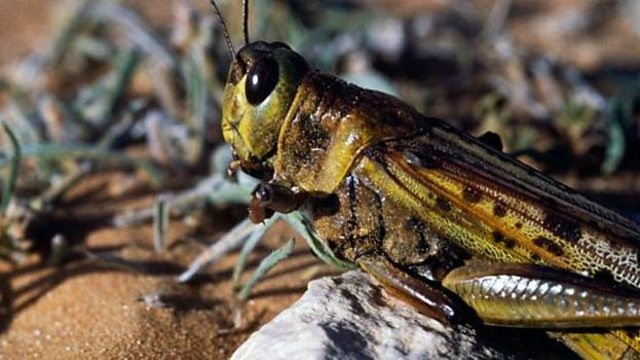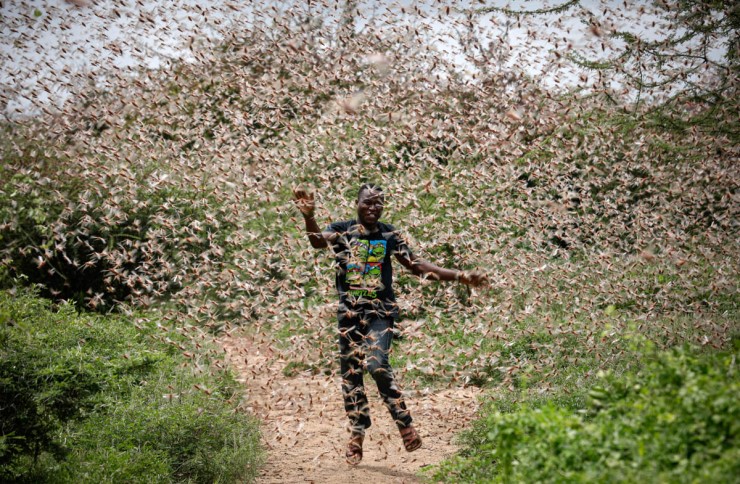Hundreds of billions of locusts are swarming through parts of East Africa, threatening crops and livelihoods. One unusually large swarm occupied an area of 2,400 square kilometers in Kenya. Even at this size, they can consume the equivalent of what at least 3.5 million people would eat in a day. These swarms typically can move up to 150km per day. The insects, which eat their body weight in food every day, are breeding so fast that the numbers could grow four hundredfold. For these reasons, locust swarms are preventing people from supplying the required amount of food.
 |
| ▲ The desert locust has mobility and breeding capacity which made more havoc damage. (Photo from BBC) |
Between October to December last year, unusually heavy rain and rising water temperatures in Africa caused the number of locusts to increase rapidly. The Indian Ocean Dipole, or Indian Nino, is a phenomenon that when it is in its positive phase, there is heavy rain in regions along the western Indian Ocean. In this case, there was a 400 percent increase in recorded precipitation over the same period recorded last year, causing flooding in numerous regions. Once those floods recede, the soil retains so much moisture that desert locust females are able to lay their eggs in favorable circumstances for around six months. This resulted in 360 billion locust swarms affecting East Africa. The World Food and Agriculture Organization (FAO) said that if the locusts continue to move through June, they could grow to 500 times bigger. At present, East Africa, especially Ethiopia, Kenya, and Somalia are facing a food crisis and in order to eradicate the pests and help save crops, the expected costs are estimated around 70 million dollars. Locust swarms moving from the East African region to the Arabian Peninsula, India, and Pakistan have already begun to ravaged crops. They are now located on the border between Pakistan and China. China has arranged a monitoring system to prevent disaster from this situation.
The damage caused by locust was first reported in the Bible. It is one of the ten disasters which occurred when Moses escaped from Egypt. In the Annals of the Joseon Dynasty, historians also recorded damage caused by locusts. Also, in 1987, swarms of locusts were found in Africa and almost every nearby region was damaged by their infestation.
In 2018, the armyworm wreaked havoc from America to Africa. According to The World Food and Agriculture Organization in Africa, about 3500 million hectares of corn were damaged by the pests. At that time, the armyworm moved to India and in Chikkaballapur, 70% of all corn was destroyed by them. The chestnut moth, which is the adult body of an armyworm, can migrate over a hundred kilometers like the locust and can lay up to 1000 eggs. However, their further spread was protected by the introduction of genetically modified organisms (GMO).
The Dankook Herald (DKH) interviewed a representative from the Rural Development Administration (RDA) about this crisis. They said they were monitoring the current situation and were actively engaged in a cooperative enterprise with China. Usually, the pests follow air flow currents. If the air current meets the right conditions, the locusts might enter Korea. However, the probability is very low. As part of the Overseas Agricultural Technology Plan Project, researchers in Uganda, Kenya, Ethiopia, and other impacted nations are monitoring the situation and trends of these destructive pests. Generally, the crisis occurs when adult larvae move locations and hatch eggs. There is a pesticide to prevent breeding and extermination, but since the desert locust is not officially registered as a pest in Korea, the relevant pesticide can’t be officially sprayed. Registration of the product would take about 15 days. If the probability of locust inflow increases, the RDA will file the request for product registration without delay. Furthermore, there is a monitoring system in place at each local government office and staff at the Agricultural Technology Center are frequently examining and forecasting the state of the pest. If the situation worsens, they will convey it to the farmers and take appropriate measures.
The reason why locusts are a problem at present is that they attack on a large scale. Being better prepared will go a long way to helping Korean farmers and consumers, avoid the same damages experienced by other nations already in the thick of it.
 |
| ▲ Desert locust invading Africa farmlands (Photo from Aljazeera) |
이지희, 박유정 dankookherald@gmail.com

![[Campus Magnifier] Let's Surf the Library!](/news/photo/202404/12496_1765_4143.jpg) [Campus Magnifier] Let's Surf the Library!
[Campus Magnifier] Let's Surf the Library!
![[Campus Magnifier] Let's Surf the Library!](/news/thumbnail/202404/12496_1765_4143_v150.jpg)





